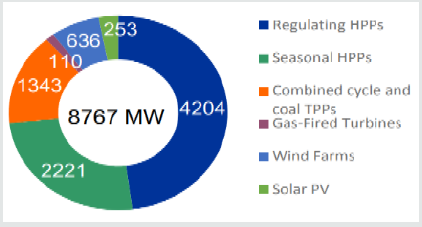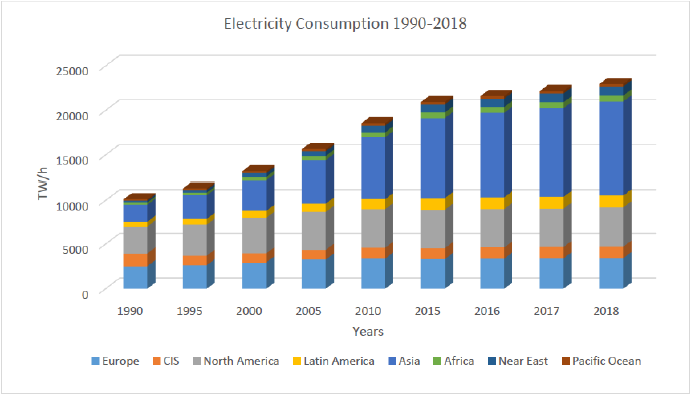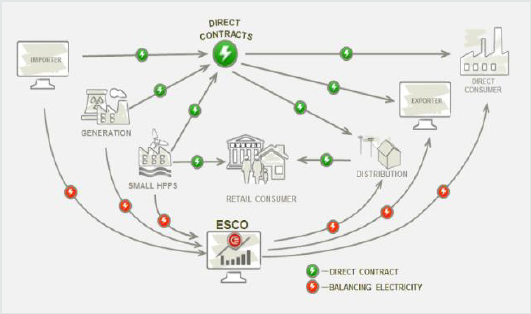
Lupine Publishers Group
Lupine Publishers
Menu
Review ArticleOpen Access 
Energy Market Liberalization, Electricity Shortage, Subsequent Challenges and Renewable (Solar) Energy’s Role Volume 1 - Issue 3
Maia Melikidze1*, Garik Teymurazyan1, Eka Okromelidze2 and Ana Kashia3
- 1Renewable Energy Sources Laboratory, Stanford university, Georgia
- 2Renewable Energy Sources Laboratory, Stanford university, Georgia
- 3Renewable Energy Sources Laboratory, Stanford university, Georgia
Received: October 09, 2020 Published: November 16, 2020
Corresponding author: Maia Melikidze, Associated Professor at Business and Technology University, Commissioner at Georgian Energy Regulatory Authority, Stanford univercity, Georgia
DOI: 10.32474/JBRS.2020.01.000111
Abstract
The research paper attempts to explore the ways to develop a state strategy for renewable energies and establish preferential
systems. The study results are based on the Desk Study methodology. The paper uses the quantitative method through statistical
data gathered from reliable sources such as state agencies and publicly accessible official sources.
The international experience on the topic has been well-researched and the necessary components needed to rehabilitate the
global energy industry in the post-pandemic period have been identified. The general list of literature includes scholarly articles
from international peer-reviewed publications, legislative and sub-legislative acts of the country, strategic documents, results of
international relevant research, and information requested from state agencies.
Keywords: Renewable energy; Energy market; Electricity shortage; Net Metering
Introduction
In the digital age, a world without technology seems very difficult to imagine. The ongoing process of technology development makes devices more compact that dramatically increases the demand for high-quality electric power. Consequently, energy consumption demand is on a rise and the trend is expected to be upward. In comparison with 1990, the global energy consumption has doubled (Table 1).
Electricity Consumption Trend 1990-2018
Europe / CIS / North America / Latin America
Asia / Africa / The Middle East / The Pacific Ocean
As the diagram depicts, global demand for energy is increasing
rapidly each year [1], and Georgia is not an exception. In the 1990s
the bulk of total energy was consumed by North America which was
later outstripped by Asia consuming 2.32 times more electricity
according to the 2018 statistics. The similar marked increase can
also be observed in Latin America, Africa and the Middle East.
The aim of the research is to identify the challenges facing
Georgia’s energy sector, explore ways to respond to them,
determine the development opportunities in the field, and tackle
the issues related to the energy market liberalization [2]. Based on
the analysis of European experience, the paper attempts to define
the stakeholder collaborative system in new business ecosystem
and offer development prospects both for businesses and the state.
Results and Analysis
Balance and Solar Energy Potential
Georgia is characterized by almost every climate zone existing
on the earth, ranging from humid subtropical to eternal snow and
glacial zones [3]. Due to its relatively low latitude and moderate
cloudiness, Georgia receives significant warmth from the sun.The
average annual sunlight is 1,350-2,520 hours. (http://energy.gov.
ge/energy.php?id_pages=60&lang=geo)
According to the Galt & Taggart research report published on
October 3, 2019, electricity import increased by 20.5% in 2019 [4].
Azerbaijan was the main provider of import with 91.1% share in
total; the rest was imported from Russia. (https://galtandtaggart.
com/upload/reports/18281.pdf) (Table 2).
Currently, the installed capacity of the Georgian electric power system amounts to 4166 MW, of which 2381 MW is generated by regulated HPPs, 839 MW by ‘seasonal’ (run-of-river) HPPs, 110 MW by Gas Turbines, 21 MW by wind farms, and 925MW by thermal power plants and combined-cycle gas turbines (Fig.1). Roughly 77% of the total in-country installed capacity is provided by HPPs. It should be noted that by 2029 share of wind and solar power plants will reach 10% and its growth is expected to remain on a upward trend (Ten Year Network Development Plan of Georgia 2019-2029, p. 10). (Fig 1&2)
Figure 1: Installed capacities of the existing power plants Source: Ten Year Network Development Plan of Georgia 2019-2029, p.11)

Figure 2: Installed capacities of power plants as for 2029 Source: Ten Year Network Development Plan of Georgia 2019-2029, p.11)

According to ESCO data, electricity supply (million kWh) for eleven months of 2019 is as follows: the share of solar energy is quite limited [5]. However, this table shows the potential solar power plants and their possible maximum power output in the future.
The Role of the State and the Net Metering System
No significant state-level steps have been taken so far towards
the solar energy sector development. It is at the expense of
enthusiasts the field is evolving. It is noteworthy that in 2016 [6]
GNERC launched the Net Metering Regulation according to which
individuals can generate their own electricity and sell the excess
electricity to the operator. As of the end of 2019, 131 customers had
been connected to the system. It is significant that solar panels are
being installed in highland settlements of Georgia. On the report
of National Statistics Office of Georgia, in 2018, 128,6 TJ electricity
was generated, which represents 0.348% of the total production.
It is a well-established method for customers to meet their
consumption needs through utilizing micro-capacity renewable
energy sources, which are supported by various international
level incentive policies. According to the information available
to the GNERC Commission, by the end of 2018, through Telasi
JSC 27 subscribers had been participating in the net metering
system with total capacity of 358.15 kW, while 40 subscribers
through EnergoPro Georgia JSC with total capacity of 381.61 kW.
Overall, in 2018, 67 subscribers were participating in the net
metering [7] system with total capacity of 739.75kW. Compared
to the previous year, net metering in 2018 can be characterized
with the following indicators: there was a 2.4 fold increase in the
number of subscribers and the installed capacity grew 2.7 times.
Not only does the net metering program enable the customers to
generate increased amount of electricity for self-consumption, but
also supply the excessive electricity to the relevant distribution
network for the corresponding payment. 2018 was marked with
the intensive work of the Commission to elaborate and further
develop net metering regulation allowing a collective involvement
of the group of customers in the net metering program.
Solar power plant generation can be correlated with the
country’s overall consumption in order to reduce daytime peak
loads. On the other hand, when clouds pass over a solar power
installation, the efficiency of the latter can drop which will create
the need for additional high-capacity power reserves to offset the
solar generation instability [8]. In conjunction with solar power
plants, battery energy storage can be used to tackle this challenge.
With its optimal settings, these batteries can bolster the country’s
use of solar energy efficiency and provide optimal supply option
such as solar energy converters.
In recent years, the interest in wind and solar power plant
construction has increased dramatically. Hence, Georgian Electricity
Transmission System JSC ‘Georgian State Electro system’ with the
support of European consultants’ consortium DigSILENT-DMCCR2B
has studied the possibilities of integrating variable renewable
energy sources in the Georgian power system. The outcome of the
study reveals that, by 2020-2021(after implementation of balancing
mechanisms), [9]Georgian power system can integrate 333 MW
wind and 130MW solar power plant (25%of potential); (GNERC
Solar energy incentive mechanism – net metering, p.25, 2018)
Liberalization of the Energy Market and Its Accompanying Challenges
The global energy market liberalization process took place
around 30 years ago with the UK being one of the pioneers to revamp
its energy system, which nowadays is considered to be a standard
model for electricity liberalization worldwide. British model was
pursued by many countries and successfully implemented. In 2001,
Norway was first to offer a European power exchange Nord Pool
which is now owned by Euronext and the continental Nordic and
Baltic countries’ Transmission System Operators (TSOs). Nord Pool
delivers power trading across Europe.
Market liberalization is a process that accompanies a free market
economy. It is the process of lessening the burdens of government
control, lifting various barriers and deregulating established tariffs.
It is worth noting that the level of liberalization greatly depends
on the legislature which tightens or relaxes restrictions at its
discretion. Georgia is planning to fully liberalize its energy market
in 2021. Georgia became committed to these reforms once it joined
European Energy Community and has been actively involved in
the preparation process since 2017 to start full liberalization of
the market. Drawing upon the world energy market experience,
energy liberalization has a favorable impact on the efficient and
ecological functioning of stable, energy-efficient electricity system
[10]. The energy market liberalization will entail more transparent,
diversified energy system focusing on promoting greater energy
system efficiency. In order for Georgia to achieve this result, it is
important to have stable macroeconomic environment, attract
investments and adopt complex approaches towards electivity
supply companies.
The main accomplishment that the energy market liberalization
will bring about is freedom of choice. New companies will emerge
that will stimulate healthier competition and market regulated
prices. In addition, market liberalization will attract more foreign
players to invest which, in turn, will encompass increased electricity
production. Another outcome of the energy market liberali will be tariff change. One of the primary goals of the reform is to
create fair and healthy business environment; therefore, as implied
by free-market economy [11], tariffs will be set by the forces of
supply and demand. Hence, the new concept of ‘hourly pricing’
will be introduced to the Georgia’s electricity sector and the whole
population. The notion signifies that there is positive correlation
between energy consumption and tariff; this means when
consumption is high, tariffs grow correspondingly, and when it is
low (mostly during the night hours), price drops accordingly. The
abovementioned factors will boost foreign investment in energy
sector as the higher business income, the greater stimulus is has to
increase its production.
In the first stage of market liberalization, tariff hike is inevitable.
Due to its electricity generation deficit, Georgia greatly relies on
import. The situation can be further aggravated by volatile national
currency which tends to fluctuate continually. The regulation
strategy will develop a competitive market; however, the factors
that hinder the process are the existence of supply and distribution
monopoly. Retail customers are deprived of a chance to change
their suppliers based on quality, price or other inadmissibility. [12]
In December 2019, the Parliament of Georgian made an initial step
forward by passing a relevant legislation as a result of which the
Energy Exchange was established by the Georgian Government.
The primary aim of the Energy exchange is to ensure the process
of energy transfer, delivery and distribution so that the consumers
can be entitled to choice and create ample opportunities as well
as desire for other companies to operate. Therefore, [13] the state
needs to adopt a new approach which will reduce government
intervention and allow all stakeholders trade at real market prices.
The liberalized energy platform will encompass two markets:
Day-Ahead Market (DAM) and Intra-Day Market (IDM), where the
latter supplements the first one and helps to keep demand and
supply in balance. Single price coupling algorithm EUPHEMIA
(acronym of Pan-European Hybrid Electricity Market Integration
Algorithm) was developed in Europe to calculate [14] dayahead
electricity prices across Europe and allocate cross border
transmission capacity on a day-ahead basis.
Georgia’s emerging market economy which is still in the
process of formation is frown upon by some who strongly and
openly oppose its way of development. Their concerns are fueled
by unstable political environment and inconsistent legislature
that pose the treat to the country. This so-called ‘transition
economy’ is the period when a country undergoes a process of
market liberalization during which any change in legislature and
its political will can put investors in vulnerable position and leave
them increasingly exposed. [15] Furthermore, there is a possible
threat posed by cartel deals that can roughly intervene in the
emergence of energy resources’ market value. (Fig 3)
Importer / Direct Contracts / Direct Consumer
Small HPPS / Retail Consumer / Distribution/
Direct Contract / Balancing Electricity
As mentioned above, by establishing Energy Exchange that
is planned to launch its operation in 2021, Georgia has moved
one step closer to energy liberalization; and in cooperation with
Electricity System Commercial Operator (ESCO), it will ensure
energy sector development and power sustainability. Energy
trading is expected to be conducted by financial instruments, [16]
such as energy derivatives, that will provide a considerable impetus not only towards the energy sector but also towards Georgia’s
Financial Exchange. On its part, the development of the financial
market ensures foreign investment inflow that entails capital
market accessibility for local businesses.
ESCO will serve as a guarantor to have all the duties and
obligations met. Customers are entitled to choose own suppliers
and individually agree on tariff and delivery terms. [17] This will
contribute to a healthier competition and market diversification.
Conclusion
Renewable energy development is primarily the main
determinant of environmental and economic upswing. For our
country, eliminating heavy reliance upon foreign oil and imported
energy remains the major challenge; thus, gaining energy
independence can lead to more stable environment.
After signing the Association Agreement with the European
Union, Georgia has made commitments in the energy sector which is
in need of systematic reforms. Due to the significance of renewable
energy development, the government expresses its readiness to
counter the existing challenges in the energy sector.
Of vital importance is for the state to provide economic
stimulus targeting at increasing ‘Green Energy’ demand and
provide effective mechanisms that facilitate renewable energy
generation. Relevant and effective legislation will contribute to
more secure environment for investors. Furthermore, conducting
researches and collecting data together with mapping out viable
long-term strategies and development schemes will induce more
active involvement of stakeholders.
References
- Bochorishvili, E, &Chakhvashvili M. (2019) Electricity Market Watch (brief overview),
- Change Measures in Georgia – Policy Indicators.
- (2019) Energy Exchange Established in Georgia.
- (2017) Electricity Market Liberalization, prospects and challenges.
- (2016) Euphemia Public Description PRC Market Coupling Algorithm.
- GNERC Solar Energy Incentives – Net Metering, (2018); Ten Year Network development Plan of Georgia 2019-2029; transmission System Operator JSC ‘Georgian State ecosystem’.
- (2017) How the European day-ahead electricity market works. ELEC0018-1 - Marche de l'energie Pr. D. Ernst Bertrand Cornelusse.
- (2017) International experience of Electricity Market Liberalization.
- Ksovreli T, Gogoladze M, Mokia K, Kinsturashvili M, Nonikashvili L, et al. (2019) Energy Balance of Georgia.
- Margvelashvili M (2015) Georgian Energy Sector in the Context of EU Association. World Experience for Georgia (WEG), Tbilisi, Georgia.
- Mukhigulashvili G, Kvaratskhelia T (2013) Renewable Energy Sources and Energy Efficiency. World Experience, Tbilisi, Georgia.
- (2020) Nord Pool Group.
- OECD (2018) Environmental Directorate. Mobilizing Financial Recourses for Climate.
- Tatarshvili, Zurabishvili N (2019) Natural Resources and Environmental Protection of Georgia. National Statistics Office of Georgia, Tbilisi, Georgia.
- (2019) The Electricity Market Operator, Electricity Balance.
- Tsurtsumia T, Janelidze S Energy Obligations Defined by the Georgia’s accession protocol to the Energy Community Treaty.
- World Energy Statistical Yearbook, Domestic Electricity Consumption.

Top Editors
-

Mark E Smith
Bio chemistry
University of Texas Medical Branch, USA -

Lawrence A Presley
Department of Criminal Justice
Liberty University, USA -

Thomas W Miller
Department of Psychiatry
University of Kentucky, USA -

Gjumrakch Aliev
Department of Medicine
Gally International Biomedical Research & Consulting LLC, USA -

Christopher Bryant
Department of Urbanisation and Agricultural
Montreal university, USA -

Robert William Frare
Oral & Maxillofacial Pathology
New York University, USA -

Rudolph Modesto Navari
Gastroenterology and Hepatology
University of Alabama, UK -

Andrew Hague
Department of Medicine
Universities of Bradford, UK -

George Gregory Buttigieg
Maltese College of Obstetrics and Gynaecology, Europe -

Chen-Hsiung Yeh
Oncology
Circulogene Theranostics, England -
.png)
Emilio Bucio-Carrillo
Radiation Chemistry
National University of Mexico, USA -
.jpg)
Casey J Grenier
Analytical Chemistry
Wentworth Institute of Technology, USA -
Hany Atalah
Minimally Invasive Surgery
Mercer University school of Medicine, USA -

Abu-Hussein Muhamad
Pediatric Dentistry
University of Athens , Greece

The annual scholar awards from Lupine Publishers honor a selected number Read More...






